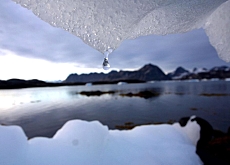Bird flu ban remains despite migration shift

The Swiss authorities say they have no intention of relaxing preventive measures against bird flu despite changes in migration patterns due to the warm weather.
Some waterfowl that would normally winter in Switzerland have stayed away because of the unseasonably mild temperatures across northern Europe.
In October last year the government introduced an outdoor ban on poultry kept within a one-kilometre radius of major Swiss lakes and rivers. This is due to remain in force until April 30.
The restrictions are designed to prevent domestic flocks from coming into contact with migratory birds infected with the H5N1 virus. Switzerland’s summertime waterfowl population of 50,000 tends to swell to 500,000 during the winter migration to Africa.
But warm temperatures – the mercury topped 15 degrees Celsius in Geneva on Wednesday – have persuaded some regular visitors to stay further north.
“It’s true that there has been a bit of a change in migration because of the temperatures but there are still many birds spending the winter in Switzerland,” spokeswoman Cathy Maret told swissinfo.
Virus
“For us the level of risk remains the same. Later this month or in February a cold front could come in and birds that are currently further north will move south. So the bird flu situation can change quickly.”
Thirty-two dead wild birds were found with the H5N1 virus in Switzerland in February and March last year, mainly around lakes. But none has been discovered since April.
Matthias Kestenholz, spokesman for the Swiss Ornithological Institute, confirmed that a number of species of waterfowl had stayed up north.
“It would be quite reasonable to say that the wintering population is maybe a little bit below average now, but we can’t say to what extent at the moment,” he said.
Kagfreiland, a farm animal protection organisation, has reiterated calls for the outdoor ban to be lifted. Director Roman Weibel said the risk factor was not sufficiently high to justify the measure.
Temperature
According to MeteoSwiss, the average temperature so far in January has been around six degrees Celsius higher than normal.
Climatologist Stephan Bader said long-range models showed that the weather would remain warm for at least the next ten days.
Martin Beniston, head of climatology at Geneva University, said statistics showed that January had been getting warmer and warmer over past decades.
“What might be a bit different this year is the persistence of this warm spell, which has been going on since October. We have had much higher temperatures for several months on end,” he said.
Beniston, however, does not believe the unusual weather pattern is directly linked to global warming. He said a combination of factors were at play: an El Nino event in the Pacific, warmer than average temperatures in the Atlantic and Mediterranean – all pumping heat into the atmosphere – and a constant south/southwesterly wind bringing warm air into Europe.
Warm spell
Antoine Guisan of Lausanne University’s department of ecology and evolution said the warm spell could affect this year’s life cycle of native plants.
He explained that some plants might start developing too early and then be damaged by frosts in February or March. Early blossoming fruit trees could be hit badly, said the assistant professor.
In the long term, he said warmer winters would lead to significant changes in the distribution of plants species in Switzerland.
“Within the last 20 years the biological spring in Europe has advanced by about a week or even more.
“Warmer and shorter winters in Europe will allow plants from lower elevations to move up mountains, threatening alpine species. We might also see Mediterranean plants invading Switzerland in the near future.”
swissinfo, Adam Beaumont
The latest lock-up – in place since October 15 – affects chickens, hens, turkeys, peacocks, guinea fowl, partridges, pheasants, quails, ducks, geese, ostriches, emus and rheas.
Throughout the winter, samples are being taken from live birds on lakes Constance and Sempach and at the Bolle di Magadino nature reserve in canton Ticino to check for bird flu.
Similar checks will be carried out on birds shot by hunters on lakes Geneva and Neuchâtel.
Peter Duelli, a senior scientist at the Federal Institute for Forest, Snow and Landscape Research, said it was too early to say whether the warm weather heralded a bumper year for bugs and ticks.
He said a cold snap in February or March would still be sufficient to keep numbers at normal levels.

In compliance with the JTI standards
More: SWI swissinfo.ch certified by the Journalism Trust Initiative










You can find an overview of ongoing debates with our journalists here . Please join us!
If you want to start a conversation about a topic raised in this article or want to report factual errors, email us at english@swissinfo.ch.